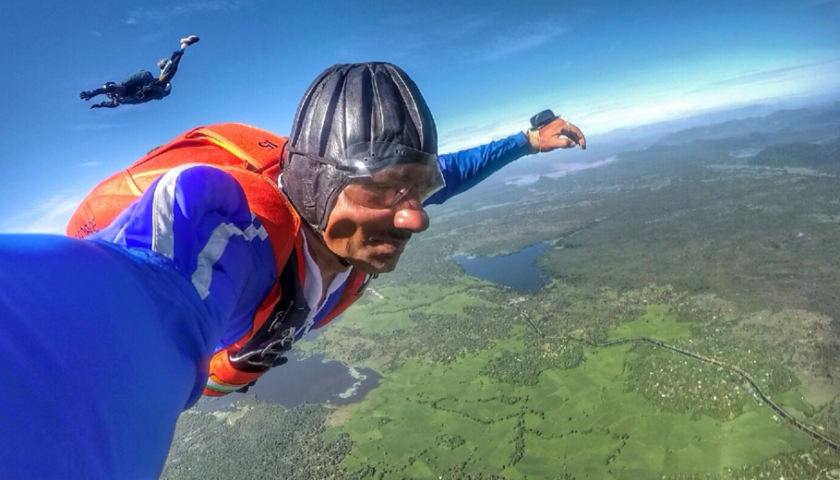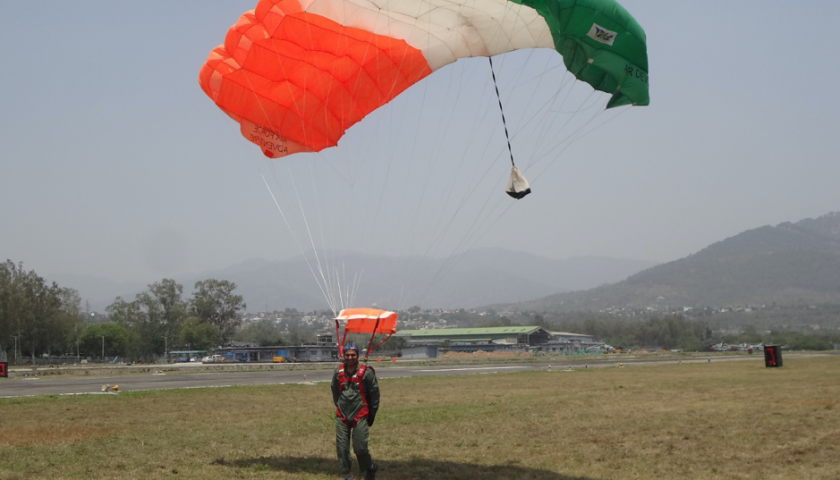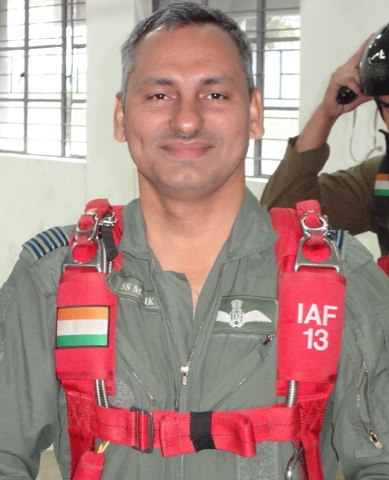The Para Training School (PTS), run by the Indian Air Force at Agra, conducts the parachuting and combat military free-fall training. The squadron insignia depicts a deployed parachute bringing down a supply container with wings attached. This signifies the role the squadron is involved in. The School was established under 50th Para brigade in 1941 at New Delhi. After the Independence, the school was permanently shifted to Agra. Earlier the Dakota, Hudson and Halifax Aircraft were used for Paratroopers Training. The School has participated in many operations of Indian Armed Forces. The PTS supported the forces in Indo-Pak wars of 1965 and 1971. The school had also participated in Operation Pawan and Operation Cactus (Maldives). The school was presented with the president Colors by then President Shankar Dayal Sharma in 1994. The School is Supported by Various Aircraft of IAF like AN-32, IL-76, C17 Globemaster and C130J Hercules for Para trooping Training. The training module includes the Para basic course. The trainee must complete 5 Para Jumps including one jump with battle load in the night. HAHO (High Altitude High Opening) and HALO (High Altitude Low Opening) jump techniques are trained for personnel. The paratroopers graduate from PTS are awarded the Coveted Para Wings. The Officers of the Parachute Regiment also do their Refresher course at PTS, Agra. The Akash Ganga Skydiving Team of Indian Air Force in also based at Paratroopers Training School in Agra.

Out of ten thousand feet of fall, always remember that the last half inch hurts the most.
CHARLES W. PURCELL
So let’s jump right out of our comfort zone along with Wg Cdr SS Malik (Retd) for an adventure in the sky and ride the winds.
- Please share some information on your educational background and reasons for joining Air Force?
I was motivated to join the Air Force when I was in 6th standard when I saw pictures of Fighter and Bombers in School Library. Subsequently, in about 2 years I had read all the books on military aircraft available in the library and fighter aircraft was what I chose as a way of life. I cleared NDA but couldn’t make it through SSB, I had to work on myself since I was from rural schools. I completed BSc Computer Science and then tried CDS but still no joy. I consistently tried and in my 7th attempt which was also the last one, I cleared SSB. But in the meanwhile, I had completed a Masters in Tourism Administration and registered as a research scholar.
- Can you elaborate on the type of training and duration which you had to undergo before getting commissioned in fighter stream of IAF?
After joining IAF, I underwent 6 months of physical and ground training, 6 months of Basic Flying Training, 6 months of Advanced flying training on a jet trainer and then commissioning. After commissioning I underwent 6 months of Fighter orientation flying and the one year of fighter training on MiG-21 aircraft. But it was one more year of operational training in squadron before I could say I was ready for war.…so to be fighter pilot capable to fight in a war, it is 4 years of training or more.
- What motivated you to try out para jumping?
During my adventure tourism study trip, I was training in Rishikesh in rapids. I met 2 Marine commandos, who described scuba diving and Para jumping to me and I decided I am going to jump like them and dive.
- Can you tell us about Para training school, and kind of training you had to undergo for earning the Para badge?
General fighter pilots are discouraged to do the para course because of a misnomer that it will lead to injury and going off flying for a year or so. Modern parachutes are good and fighter pilots have good flying sense so chances of injury are very less. I had a flight commander who was very kind and logical, he allowed me to join this course. It was a 10 days course in which 5 days were for ground training and rest 5 days for 5 jumps but I volunteered for more and did 7 jumps. Next year, I sacrificed my leave and did advanced skydiving course. There we did a lot of physical and emergency handling training and then about 10 skydives. I was fearless from beginning and good in canopy flying. After this camp I was chosen for demo jump in Ambedkar Stadium in Delhi, followed by a demo jump in Ambala in a crowded place. For all this, I had a lot of support and appreciation because I used to finish my work in the squadron including flying, therefore, I could muster courage and ask permission to participate in such adventure events.

Skydiving is like making love to the world.
FAUSTO BRIZZI
- The first jump like the first solo is very special, can you tell us about that.
The first static line jump was to be done as a drill without thinking, in a dash, so that you do not get time to think. Keeping the body tight is a way to overcome fear. I just remember the sinking feeling and then parachute started opening. After parachute opened it was like a real feeling of flying like a bird, the wind is hitting the face and shrieks of joy emanating involuntarily. It was really awesome, something which I had never experienced before. Like a wish, we make when we were children of flying above the clouds, that wish getting fulfilled. During flying, cockpits shields you from the surrounding environment, in a parachute or paraglider those limitations are not there.
The first skydive is more thrilling as this negative g (sinking feeling) lasts longer approx. 5 seconds but we keep arching hard and do our drill. The bright aspect was that I was able to maintain that position and was stable in free fall.

- Tell our readers about various kind of para jumps- para jump, free fall, group jumps, HAHO, HALO and LALO and different types of records etc,
The above terminologies are used for military skydiving and not for sports skydiving. In sports, skydiving are freestyle (individual acrobatics), Relative work- group of skydivers flying together and CRW- canopy relative work- 3 or more canopies flying together. Now wingsuit flying and water jumps etc have also been added. I was good in acrobatics because every training jump which we did from 4500 or 5000 feet I used to get 12-14 sec till 3000-35000 feet and used to complete one back loop one right turn one left turn and open parachute by that altitude after stabilising. This I must have done more than 100 times.

- What is your speed during free fall? When you open the parachute what kind of precautions do you have to observe? Do you have any standby parachute specially in case if parachute does not open?
The speed during free fall increase at the rate of 8m/s i.e about 30 feet per sec. It can be further increased by making specific aerodynamic positions such as delta position. The max speed is limited by a velocity known as terminal velocity which is when air resistance equals to acceleration due to gravity and speed stabilises. There is a spare/reserve parachute and automatic deployment instrument which will automatically open the parachute at 1000 feet in case you fail to do so.
- What precautions do you take as come down close to ground? Are there chances of injury to para jumper?
Close to ground precaution start from time when you set your finals turn assessing winds and intended place of landing. Control of speed and rate of descent (steady flying with no turns is the key) are two important factors to prevent injuries.

- How is jumping at night different as the jumper cannot see the obstacles, terrain.
Jumping in night is an operational necessity. In sports skydiving it is done with glow lights and fairly lit up drop zone.
- Para Jumping is an adventurous activity not suitable for everyone. Sometimes the conditions change very fast which make landing unsafe. Did you ever face any close escape situation?
Para jumping is a calculated risk. The sport is safe when one is physically fit and properly trained. There may be times when thing do not go as planned and emergency drills need to be done fast and right. Weather also plays a role in this. I was jumping in a stadium and was at finals when winds picked up and started pushing me out. I tried hard by increasing my speed but had to make a split-second decision to land outside, otherwise, I would have scraped my back in this process. The area outside was full of tall, mature trees, a road, a fence and a parking area. As soon as I turned, I found myself heading towards a big tree, At that time some natural instinct for survival got activated and instead of being afraid my mind was continuously giving solutions. I turned back to right and the quickly to left as I came down and continuously assessing my landing point. I managed to escape unhurt by landing in a 3-meter zone between fence and parked motorcycles. The parachute was safe too. It was a close escape. I had 3 more close escapes during flying about which I will write later.

Wg Cdr SS Malik (Retd) got commissioned in Jun 1997 and has flown HPT-32, HJT-16, Iskra, MiG-21 (3 types), two types of microlight aircraft, Su-30K and Su-30 MKI aircraft with maximum experience od 13 years on Su-30 MKI on which he was also a production test pilot accumulating approx. 2800 h of flying experience. He has a keen interest and appetite for all kinds of adventure sports like mountaineering, rafting, scuba diving and trekking. He was appointed as Director of Indian Mountaineering Foundation for a brief period and Director of Air Force Adventure. In his words, “Only two things I really loved were adventure and flying and I was able to achieve them both in IAF, I couldn’t have chosen a better career”.



